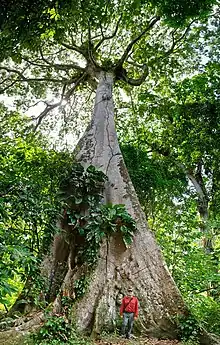Dinizia excelsa
Dinizia excelsa is a South American canopy-emergent tropical rainforest tree species in the family Fabaceae, native to primarily Brazil and Guyana.[4][5] In Portuguese it is known as angelim vermelho, angelim, angelim pedra, and paricá, or sometimes angelim falso, faveira, faveira-dura, faveira-ferro or faveiro-do-grande.[6] In Trio it is called awaraimë. In Wapisiana it is called parakwa.
| Dinizia excelsa | |
|---|---|
 | |
| Scientific classification | |
| Kingdom: | Plantae |
| Clade: | Tracheophytes |
| Clade: | Angiosperms |
| Clade: | Eudicots |
| Clade: | Rosids |
| Order: | Fabales |
| Family: | Fabaceae |
| Genus: | Dinizia |
| Species: | D. excelsa |
| Binomial name | |
| Dinizia excelsa | |
Description
It is one of the tallest tropical tree species, growing 60 m (200 ft) and taller. The unarmed, trunk is cylindrical, the bole of larger specimens 15-22.5 m, up to 3 m in diameter at soil level. The DBH of mature specimens is typically between 80 to 200 cm (31 to 79 in), moderately to strongly buttressed, the buttresses to 4-5 m tall.[7][5]
The heartwood is reddish brown with a slightly paler sapwood. The wood is durable and difficult to work with due to its density and irregular grain.[4]
Distribution and habitat
It is found in Guyana, Suriname and Amazonia Brazil (in the northern and central-western states of Amapa, Amazonas, Mato Grosso, Para, Rondonia, Roraima and Tocantins). Also recorded from the state of Acre by Lorenzi (1992).[8]
The species grows in non-inundated moist and upland mixed forests known as "floresta ombrofila mista", tropical forest on "terra firme", tropical upland evergreen forest, and tropical dry forest.[7] It has been recorded at elevations from 50-490 m.[7]
Tallest tree
The tallest measured specimen is 88.5 m (290 ft) with a circumference of 5.5 m (18 ft), which is believed to be about 400 years old, discovered near Jari River in Inipuku (municipality of Almeirim, Para state) in 2019.[9][10] The discovery was made using airborne laser scanning (ALS) and field verification in Paru State Forest, which is shared by the Brazilian Amazon basin states of Amapa and Para.[11][12][13]
See also
References
- iucnredlist.org / Angelim
- tropicos.org / Dinizia excelsa Ducke
- theplantlist.org / Dinizia excelsa Ducke
- wood-database.com / Angelim vermelho
- plantsoftheworldonline.org / Dinizia excelsa Ducke
- Lorenzi (1992).
- Lewis GP et al. 2017. The majestic canopy-emergent genus Dinizia (Leguminosae: Caesalpinioideae), including a new species endemic to the Brazilian state of Espírito Santo. Kew Bulletin 72:48. DOI 10.1007/S12225-017-9720-7
- gbif.org / Dinizia excelsa Ducke, 1922
- inverse.com / The Amazon’s Tallest Trees Are Safe (for Now), By Nina Pullano on September 12, 2019
- mongabay.com / LIDAR technology leads Brazilian team to 30 stories tall Amazon tree, by Jenny Gonzales on 11 November 2019
- Gorgens, Eric Bastos; Motta, Alline Zagnoli; Assis, Mauro; Nunes, Matheus Henrique; Jackson, Tobias; Coomes, David; Rosette, Jacqueline; Aragão, Luiz Eduardo Oliveira e Cruz; Ometto, Jean Pierre (September 2019). "The giant trees of the Amazon basin". Frontiers in Ecology and the Environment. 17 (7): 373–374. doi:10.1002/fee.2085. Retrieved 5 December 2020.
- Langlois, Jill (27 September 2019). "Researchers Discover the Tallest Known Tree in the Amazon". Smithsonian Magazine. Retrieved 5 December 2020.
- theconversation.com / The Amazon’s tallest tree just got 50% taller – and scientists don’t know how, September 11, 2019
